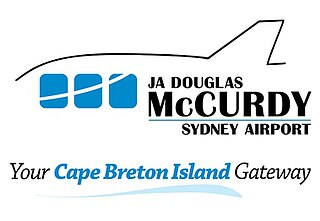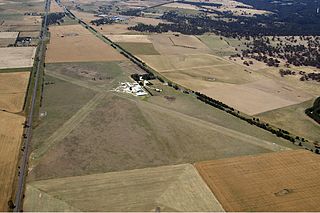
JA Douglas McCurdy Sydney Airport is a regional airport located in Reserve Mines in the Canadian province of Nova Scotia. The airport serves the Cape Breton Regional Municipality (CBRM) and the surrounding areas of Cape Breton Island. McCurdy Sydney Airport has the distinction of being the oldest public airport in Nova Scotia, first licensed on August 3, 1929.

Hoxton Park Airport was a general aviation aerodrome in south-western Sydney, New South Wales, Australia.
Goulburn Airport is a general aviation airport located 7 km (4.3 mi) south of Goulburn, New South Wales. Throughout the 1990s, suggestions were put forward to have Goulburn airport as a secondary international airport to service Sydney.

Camden Airport is an aerodrome located on the outskirts of Sydney, 1 nautical mile northwest of Camden, New South Wales, Australia. The airport is located approximately 60 km (37 mi) from Sydney's central business district. Camden is used as a general aviation overflow airport for the busier Bankstown Airport, and provides facilities for gliding and ballooning. The aerodrome has one grass runway and one paved runway and two glider airstrips. It is in the south-west corner of the designated Sydney flight training area.
Karnal Aerodrome is being operated as a pilot training institute owned and operated by Haryana Institute of Civil Aviation (HICA) under guidance of Civil Aviation Department, Government of Haryana. The flying school is spread over an area of 104 acres and is situated about 3 km east of Karnal in the state of Haryana, India.

Bathurst Airport is an airport serving Bathurst, New South Wales, Australia.
Moree Airport is an airport in Moree, New South Wales, Australia. The airport is 5 km (3.1 mi) from the city center. The airport has some scheduled services but mainly provides general aviation facilities, maintenance and support for agricultural aviation in the local area. The Moree Aero Club has been based at the airport since 1952, and today provides aircraft hire and flight training. The club was instrumental in providing many early improvements to the aerodrome facilities, including hangars and a terminal building. In the 2021-22 Financial Year, Moree Airport handled 18,073 passengers, down from approximately 35,000 per year before travel restrictions were introduced as a result of the response to the COVID-19 pandemic.
Moruya Airport is an airport located 3.5 NM northeast of Moruya, New South Wales, Australia, at the mouth of the Moruya River. It is one of two airports with regular passenger flights in the state's South Coast region, but also caters to general aviation and tourism operators, as well as emergency services.

Evans Head Memorial Aerodrome is a heritage-listed airport in Evans Head, Richmond Valley Council, New South Wales. The airport is approximately 1 km (0.62 mi) north of the village. During World War II it was Royal Australian Air Force (RAAF) Station Evans Head supporting RAAF No 1 Bombing and Gunnery School (1BAGS) and subsequently the RAAF No 1 Air Observers School. At the height of operations there were three asphalt runways and one grass strip. Only a single asphalt strip is still in use by private aviation. It was added to the New South Wales State Heritage Register on 22 November 2002.

Toowoomba City Aerodrome is an airport located 2.2 nautical miles northwest from the CBD of Toowoomba, Queensland, Australia. Toowoomba City Aerodrome is both licensed and certified. The aerodrome is owned and operated by Toowoomba Regional Council. Being certified means the airfield is able to have airlines and larger charter aircraft operate from the aerodrome. Being licensed means that the aerodrome is regulated by federal transport security regulations. Toowoomba City Aerodrome does not have a control tower; however the airfield is regulated and operated under Civil Aviation Safety Authority (CASA) regulations of aviation operations at non-tower controlled aerodromes.
Bunbury Airport is an airport servicing the Western Australian city of Bunbury. Bunbury Airport is located 8 km (5.0 mi) south-east of the city centre and is the only airport serving the city. The airport is used largely as a facility for General Aviation, pilot training and emergency services. Bunbury Airport serves an area that includes the City of Bunbury and the surrounding districts of Harvey, Dardanup, Capel and Donnybrook-Balingup.
Gawler Aerodrome is located in Gawler, South Australia. The aerodrome is owned by the Light Regional Council of South Australia and is managed on their behalf by the Adelaide Soaring Club (ASC).

Temora Airport is a small airport located 2 nautical miles northwest of Temora, New South Wales, Australia. Currently no regularly scheduled passenger fights serve the airport. The current owner, the Temora Shire Council, do not charge landing fees for aircraft to use the facility, encouraging a wide variety of general aviation uses, including skydiving, gliding, flight training, kit aircraft assembly and aircraft maintenance. It is also the home of the Temora Aviation Museum, and hosts regularly flying displays and events.

Tumut Airport is a small airport in Tumut, New South Wales, Australia. The airport was constructed during the 1960s, replacing an earlier airfield known as Butler's Field on a nearby private property. The airport caters mostly to general aviation and recreational category aircraft, and is located within two hours flying time of both Sydney and Melbourne, half an hour from Canberra and within minutes of Wagga Wagga Airport offering major aircraft maintenance facilities.
Scone Memorial Airport, is a public airport in the Upper Hunter Valley, 4 km (2.5 mi) northwest of Scone, New South Wales, Australia. It was built to provide a public aerodrome replacing Nandowra aerodrome on located on "Nandowra", approx. 9 km south of Scone.

Lethbridge Airpark is a privately owned aerodrome located 6 km (3.7 mi) north of the rural township of Lethbridge between the regional cities of Geelong 35 km (22 mi) to the south and Ballarat 50 km (31 mi) to the north in Victoria, Australia. The 80 ha site caters to private and recreational pilots, and offers flight training. Current facilities at the airport include several hangars, an aircraft maintenance workshop, and basic amenities including toilets and showers.
Maitland Airport, also known as Russell Field is a general aviation airport located in the suburb of Rutherford, approximately 5 km (3.1 mi) from Maitland in the Australian state of New South Wales. There are currently no airline services, with the airfield catering mostly to general aviation and recreational category aircraft. The airport has been owned and operated by the Royal Newcastle Aero Club since 1963 and shares a large training area with the nearby Cessnock Airport. Throughout its history, the airport has played host to many airshows, races and flying competitions. The field is named for the fifth President of the Royal Newcastle Aero Club, Robert Russell, who suffered a fatal heart attack while on the premises in 1966.
Wedderburn Airstrip is an unlicensed private airfield located in Wedderburn, New South Wales, an outer rural suburb of Sydney, Australia. The airfield caters to recreational aircraft owners and pilots, all of whom are members of the New South Wales Sport Aircraft Club.

Caboolture Airfield is an aerodrome catering to general aviation and ultralight aircraft located in Caboolture, Queensland, Australia, approximately 55 km (34 mi) north of the state capital Brisbane, adjacent to the Bruce Highway. The airfield is maintained and operated by the Caboolture Aero Club Incorporated and shares a large training area with nearby Caloundra Airport and Redcliffe Airport. The airfield is a popular site for the restoration of historic aircraft and a number of associated businesses are located onsite.
Mercer Airfield is an uncontrolled aerodrome 3.23 NM (6 km) northeast of Mercer Village in the Waikato region of New Zealand.










